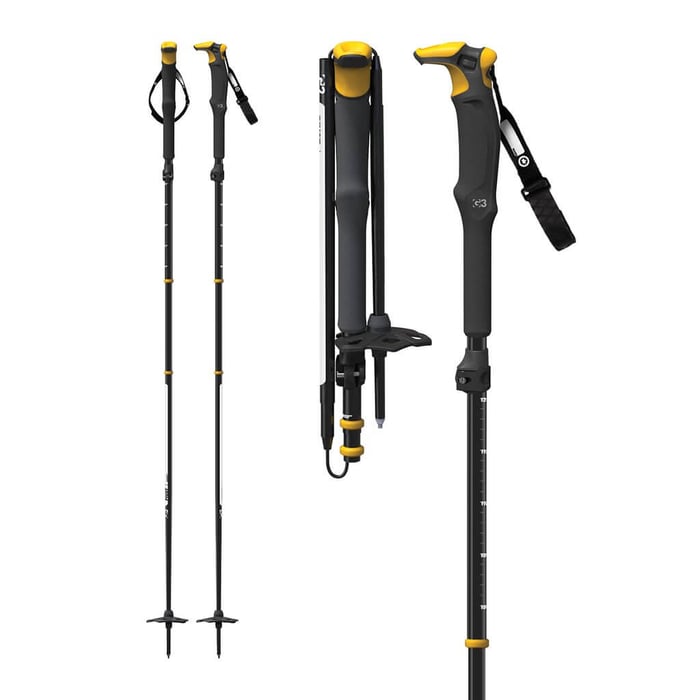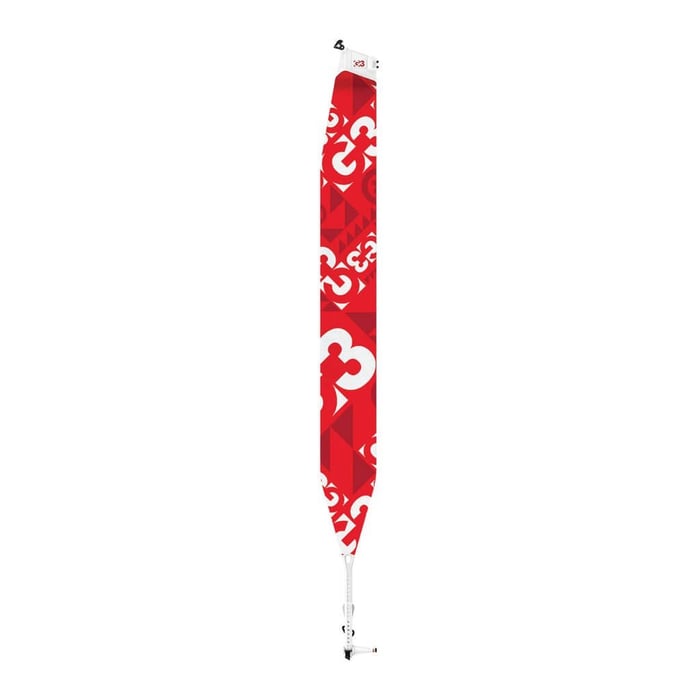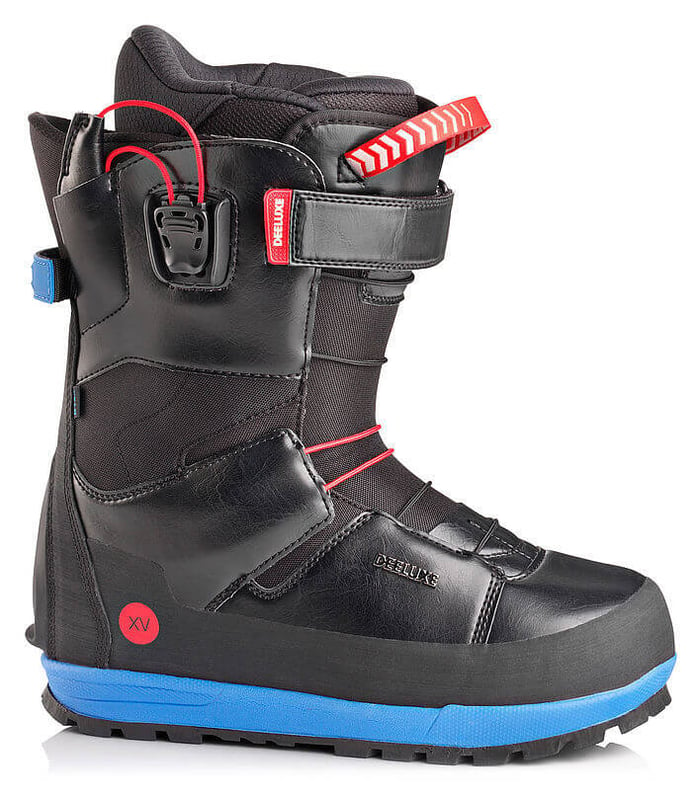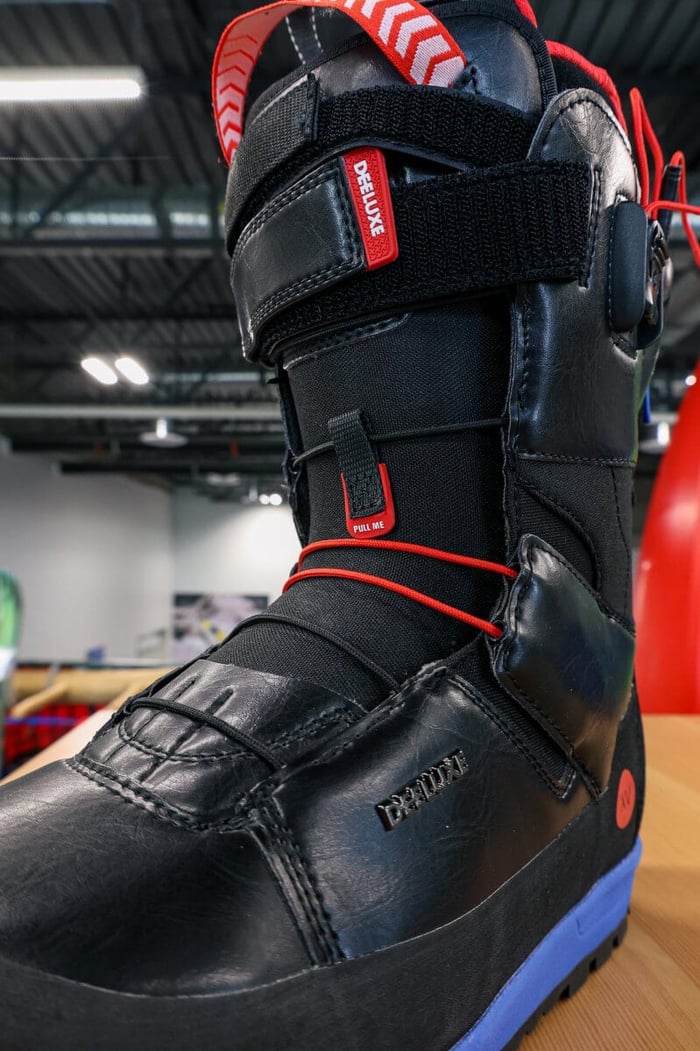Splitboard poles are an important piece of gear for the backcountry. As snowboarders, we don’t use poles on resorts, but we still need them while touring.
They help while climbing, and are great if you fall in deep snow and need a boost to stand up. As far as backcountry requirements, proper collapsible ski poles are critical.
A Quick Look at Splitboard Poles
What are Splitboard Poles?

The good news for your buying options is that there is no such thing as a splitboard-specific pole. Any collapsible ski pole will do. They all accomplish the same thing: help you ski up the mountain, float in deep snow, and pack down for easy storage.
Collapsibility is also important, so you can store them (or at least make them shorter) for your ride down the mountain. For us snowboarders, carrying fixed length poles would make descents much trickier.
Another difference between backcountry poles and “conventional” fixed length cross-country and resort ski poles are big powder baskets: these prevent the poles from sinking in powder conditions. They float on top of the snow.
Here at AQ Outdoors and Splitboard HQ we sell a variety of poles from different manufacturers.
Why Do You Need Splitboard Poles?
Would you cross country ski without poles? Well, that’s what splitboarding would be like without them! Trying to ski up a mountain without poles for stability, and to push off of, would be a frustrating time.
And, although less important (especially if you have strong snowboarding skills in deep powder) is when you fall, slip, or crash. Having poles nearby gives you something to push off of and stand back up.
Sometimes, the snow is so deep, that if you take your snowboard off and re-organize yourself, your feet sink in loose snow. This is also where splitboard poles are important. I know I’ve used mine plenty for balance in deep powder and don’t want to imagine what it would be like without them.
These reasons why it is important to invest in strong, well-made poles that you can trust.
How Do You Use Splitboard Poles?
Using splitboard poles is straightforward: just extend the poles for full use when you climb up the mountain. The action while climbing is the same as cross country skiing. If you’ve never cross country skied, the motion is intuitive and you’ll pick it up quickly. Then collapse the poles for the ride down.
Nothing much more to it!
One of the bigger questions here is how you stash your poles on the ride down.
You can carry them in hand, attach them to external holders on their backpack, or pack them away in a backpack.
Different conditions, and skill levels, call for different actions.
I carry mine in hand on descents, so they’re ready in case I crash or lose speed in deep powder. That being said, many other splitboarders I tour with pack them away, so their hands are free and they can focus on the ride.
If you know you’re snowboarding into a long, flat traverse, you might even want to keep them fully extended to help push you along if you start losing speed.
Everyone will use touring poles slightly differently, and after some time you’ll figure out your preferences too.
How to Choose Splitboard Poles?
There are many different considerations with splitboard poles: cost, materials, fit, function, weight. Come visit our store to try out the different options and figure out what works best.
One of the biggest factors influencing cost is the weight: more expensive poles are lighter. This makes a difference while climbing, and on multi-day trips, as it means less weight for you to haul around.
Folding Splitboard Poles
Another bigger difference is how the poles collapse: some use telescoping systems with cams, others fold and then use a tension string to pull the sections together. Both have adjustable heights. The 4 piece "tent pole" style poles are easier to fit into a backpack, but are less strong.
The clamping style may not fit in your backpack, but have a higher weight rating and are more robust.
There are also whippet poles, with a small removable ice pick at the head. This is for steeper terrain, negotiating couloirs, and glacial travel.
Whippet Style Splitboarding Pole
When you do find a ski pole that suits your budget and expectations, the next step is to properly size them.
As a basic starting point, when the pole is fully extended, you want the handle to reach your armpit, and for the end of the pole to be on the ground. But you need to also take your snowboard boots and snow depth into consideration! Typically, when you're climbing on your splitboard you'll have the poles extended to a length that has your elbows bent at 90 degrees when the pole is on the ground.
If you can bring your snowboard boots to the shop, great. If you’re ordering online, take a measurement from your armpit to the ground while wearing your boots.
Finally, for either method, you want to add extra length as your pole will likely sink a little in snow in the backcountry. For this reason, add 2” to your final measurement. This will give you your ideal splitboard pole length.
Final Thoughts
Splitboard poles play an important role climbing up a mountain and keeping your balance for your day out in the backcountry.
There are many different brands and styles to choose from -- don’t hesitate to reach out to us with any questions you have, or visit us in store!
Splitboard HQ Splitboard Pole Collection
G3 Pivot Poles

$193.00
What Are Splitboarding Poles? G3 Splitboard Pole Review The G3 Pivot Poles feature superior packability and strength. When combined the G3 Pivot Poles creates the ultimate packable pole for splitboarding and backcountry travel. Ships from Calgary. Features Secure packing Light… Read More
Other Splitboarding Articles
Do I Need Specific Boots for Splitboarding?
Detailed Splitboard Boot Features
Avalanche Safety Gear for Splitboarding
AQ Outdoors Contact
Edmonton: (p) 780 463-4892 (e) info@aquabaticsedmonton.com
Calgary: (p) 403 288-9283 (e) info@aqoutdoors.com
About the Authour: Dan used to instruct for AQ Outdoors and spent his 20s chasing whitewater up and down the Rockies and across Western Canada. He can still be found surfing local waves, trying to get some old moves back. If you are a mountain biker checkout his site Hardtail Canada.























































